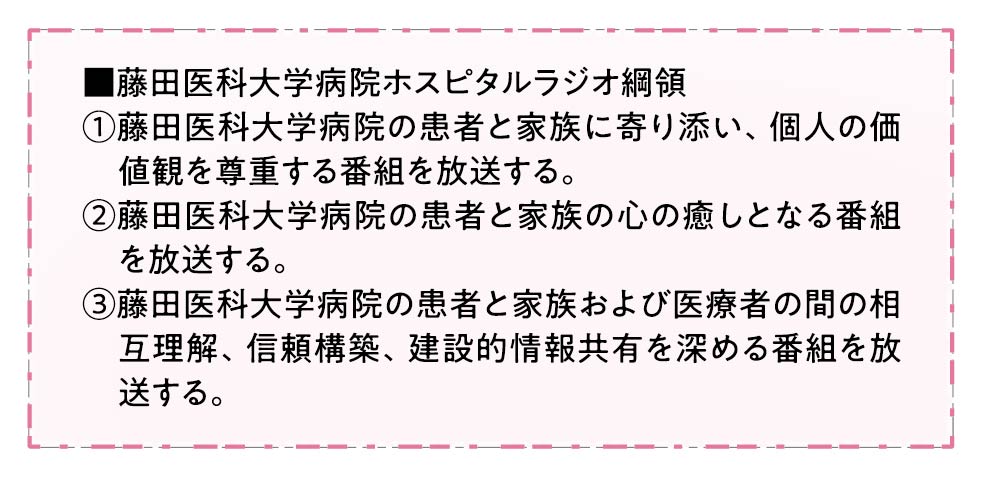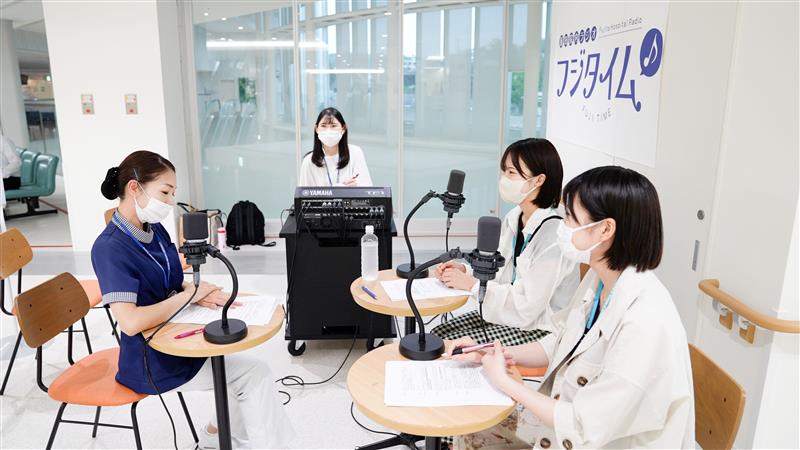Fujita Health University Hospital launched its in-house radio program, "Fuji Time," in December 2019. It has been well received by patients and is also attracting attention as a form of hospital public relations. It is currently streamed on YouTube, with approximately 1,300 subscribers (as of the end of February 2025). We spoke with Ando and Kojima from the hospital's Planning and Public Relations Office about the program's purpose and operations.

—How did "Fuji Time" come about?
Ando: It all started when Katsuyuki Goto, then an editorial writer for Chubu Nippon Broadcasting (CBC) and a council member of Fujita Gakuen, which runs our hospital, suggested to Chairman Hoshinaga Kiyotaka that we start an in-hospital radio station. On his own radio show, Goto heard from Professor Akiko Ogawa of Ritsumeikan University's School of Film and Media Studies that in-hospital radio was popular in the UK, which made him think it might be a good idea to try it in Japan as well. At the time, the Planning and Public Relations Office, together with the hospital director at the time, was thinking about how to come up with something that would be entertaining at the bedside for hospitalized patients who were unable to participate in seasonal events at the hospital. With the aim of starting an in-hospital radio station, we called for volunteers in July 2019 and formed a working group of interested people.
Initially, the group consisted of five or six members, but gradually the number increased. We moved forward with the project, with Goto joining the working group and offering his advice, and Professor Ogawa also providing information on the state of hospital radio in the UK.
Kojima: At that time, the working group created a platform (see table) that outlined the general objectives and other details for launching radio broadcasting, and this was approved by the board of directors.
—Please tell us about the current staff composition and how the programs are produced.
Kojima: Currently, the working group includes 12 staff volunteers, 13 student volunteers from Fujita Health University, and three people from the Planning and Public Relations Office. Members meet once a month to decide on themes for the talks. Talk topics include seasonal topics and hobbies, introductions to hospital amenities, the latest medical information explained by doctors and university faculty, and interviews with paramedical staff. Themes are decided two months before the broadcast date, and recordings are generally made one month before, with the recordings completed about one week before. The Planning and Public Relations Office is responsible for managing the schedule and allocating members.
Ando: We ask someone with editing skills from the Fujita Gakuen Headquarters Public Relations Department to do the editing.
Kojima-san: Currently, we send out updates twice a month, on the first and third Wednesdays. We set this frequency because we believe it is a good interval for patients who are hospitalized for about 10 days to two weeks.
Ando: The broadcast lasts just under an hour, and we don't play music due to copyright restrictions and the broadcast time being too long. We choose books that are out of copyright for reading. Our policy is to have people from various professions come together and talk about everyday topics in a friendly atmosphere, so there are no strict rules.
Kojima: However, we have a rule not to use medical terms, especially abbreviations, because they are difficult for patients to understand.
Ando-san: The Planning and Public Relations Office creates flyers for each session and places them around the hospital. We believe that flyers are essential to attracting patients' interest.

What were some of the challenges you faced when starting out?
Kojima: To begin with, we didn't know how to produce or run a radio program. Since we were all amateurs, the technical hurdles of broadcasting live, such as word choice, were high, so we decided to record it. Any mistakes could be covered by re-recording or editing.
The scripts are written by a member of the Planning and Public Relations Department. It takes time to write down every single comment made by the MC, but recently the MCs have become more accustomed to recording, and this has become easier to do.
Kojima-san: We also considered the broadcasting method from scratch, and initially, we streamed the program to patients via the hospital's free Wi-Fi. The recording equipment was purchased using the hospital's budget.
Ando: The first episode was broadcast on December 18, 2019. Soon after, the COVID-19 pandemic hit, and we discussed whether it was okay to record the show. However, after getting advice from an infectious disease specialist, we recorded it in a large conference room, maintaining a distance between people and setting up acrylic panels.
-What are the positives of choosing the radio format, and what has been the reaction from patients?
Kojima: The reason we chose radio is that hospitalized patients can close their eyes and listen at their leisure.
As a rule, we don't make videos because viewers have to concentrate on the screen when watching videos, but we have made videos a few times so far. For example, to commemorate the 100th broadcast, we walked around the hospital grounds to introduce walking courses, and we also read picture books to children, played hand games, and showed them how to fold origami. All of these videos were viewed many times and were well received.
Ando: Since the COVID-19 pandemic ended, we have been able to hold public recordings, and hospitalized patients come to watch the recordings.
Kojima: I receive letters from patients saying, "Hearing everyone's happy voices is so healing." Some people even leave comments on YouTube, so I think they look forward to it. I hope this will become a place where patients can express even a little bit of their feelings about their illness and their struggles with illness.
Ando: There was also an unexpected effect. It was improved communication between the various professions within the hospital. By working together on the program and having them appear on it, we were able to see each other's faces, and now when we have a question about work, we can ask them right away.
-What advice would you give to hospitals that want to start in-house radio broadcasting?
Ando-san: You don't need professional equipment; you can even record with a smartphone. However, you need to carefully prepare the direction and content in advance. Rather than aiming for perfection from the start, it's probably best to start small.
Kojima: I think it's best to try it once and then continue it irregularly.
Ando: It can be difficult at times, but I think you can have fun while doing it.

The public recording
▼[Hospital Radio] Fuji Time
https://youtube.com/@fujitime2019?si=-ChgSACgjtYsxH0X